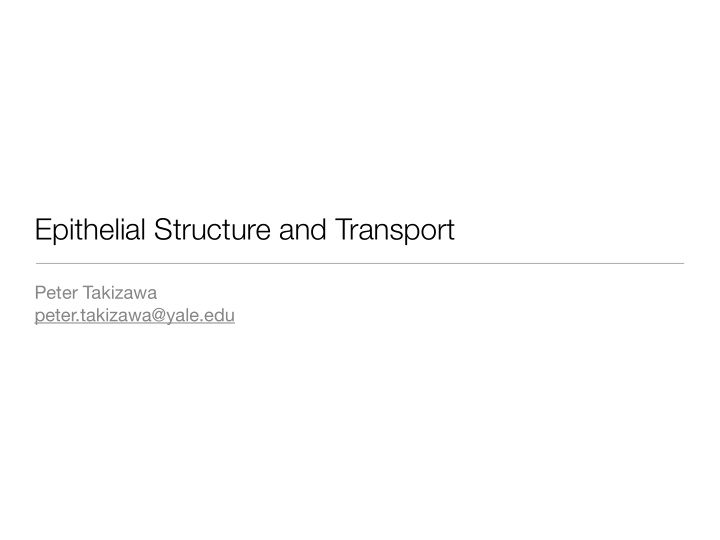



Epithelial Structure and Transport Peter Takizawa peter.takizawa@yale.edu
What we’ll talk about… • Review of types of epithelia • Epithelial cell polarity • Adhesion between epithelial cells • Vectorial transport across epithelia • Basement membrane • Renewal of epithelia
Epithelia form an interface between the human body and external environment. Gastrointestinal Respiratory Skin Tract Tract
An epithelium is a sheet of cells that can cover a large surface area.
Epithelia are classified based on the shape of its cells and the number of layers of cells. Microvilli Simple Squamous Simple Cuboidal Simple Columnar Cilia Stratified Squamous Stratified Cuboidal Pseudo-stratified Basement Membrane
Polarity of epithelial cells is critical for their function. External environment Apical Lumen Apical Interstitial Basal Basal fluid
Proteins are sorted in the trans-Golgi network and delivered to apical or basolateral cell membrane.
Transcytosis mediates transfer of protein across epithelial cells. Apical Basal
Minus ends of microtubules face the apical surface. Apical Microtubule Basal
Adhesion
Epithelial cells are held together by several junctional complexes. Lumen or external environment Apical Tight Junctions Adhering Junctions Desmosomes Gap junctions Integrins Basement membrane Basal Interstitial Fluid
Adhering junctions form a belt-like zone around epithelial cells. Apical Actin-myosin Cadherins Basal
Contraction of myosin-actin filaments changes cells shape to generate different structures. Sheet Contraction of myosin filaments Tube
Transport of solutes across epithelia
Epithelia control the passage of solutes and fluids between different fluid compartments. Epithelium External Fluid Interstitial Fluid Solutes Interstitial Fluid Fluid
Voltage across an epithelium can be measured to determine the resistance of the epithelium. Transepithelial Voltage Interstitial Lumen Epithelial Cell space
Transcellular and paracellular pathways allow passage of solutes and fluid. Paracellular Transcellular Interstitial Fluid
Tight junctions
Tight junctions form a network of sealing strands that encircle epithelial cells. Apical
Claudins are the primary component of tight junctions that determine permeability. Cell 1 Cell 2
Interactions between claudins generates size restrictive pores.
Tight junctions are located close to the apical surface. Desmosome Tight Junction Cell membrane 1 Apical Surface Cell membrane 2 Adhering Junction
Tight junctions restrict the diffusion of proteins in the cell membrane to maintain cell polarity. Tight junction Tight junction
Transport across epithelia
Vectorial transport is the movement of specific solutes or water from one compartment to another. Epithelium External Fluid Interstitial Fluid Solutes Interstitial Fluid Fluid
Sodium chloride absorption is mediated by sodium channels in the apical cell membrane. Na + Absorption 3 Na + 3 Na + 2 K + ATP Epithelial cell ADP + P i Basolateral membrane Apical membrane 2 K + Tight junction Lumen fluid Interstitial fluid 3 Cl- Lumen is negative relative to interstitial fluid
Potassium channels in the apical membrane mediate secretion of potassium. K + Secretion 3 Na + 3 Na + 2 K + ATP K + ADP + P i Lumen Fluid K + 2 Cl -
Sodium chloride secretion is mediated by chloride channels in the apical cell membrane. Cl - Secretion 3 Na + 2 K + ATP 6 Cl - ADP + P i 5 K + Lumen Fluid 3 K + 3 Na + 6 Cl - 6 Na + Co-transporter cycles three times
Glucose uptake is mediated by the sodium-glucose co-transporter in the apical cell membrane. Glucose Absorption 3 Na + 2 K + 3 Na + ATP ADP + P i 3 Glucose 2 K + 3 Glucose 3 Cl -
Basement membrane
All epithelia rest on a basement membrane. Epithelial Cells Basement membrane
The basement membrane is a meshwork of interconnected fibers.
Type IV collagen is the main structural component of the basement membrane.
Laminins form network and organize components of the basement membrane. Integrin Binding Perlecan Binding Nidogen Binding
Integrins in epithelial cells bind laminin and fibronectin in basement membrane. Actin filaments Epithelial Cell β -subunit α -subunit Basement membrane
Basement membrane restricts invasion of malignant cells. Normal Epithelium Carcinoma in situ Carcinoma Confined by Crossed basement basement membrane membrane
Renewal of epithelia
Intestinal epithelial stem cells resides in niche at the base of the epithelium.
Growth factors regulate the cell division of cells in different regions of the epithelium
Wnt increases concentration of β -catenin allowing cells to grow and divide.
Mutated APC leads to elevated beta-catenin in nucleus and cell proliferation. Normal Adenoma
Take home points... • Tight junctions regulate the paracellular diffusion of small molecules and ions across an epithelium. • The basement membrane provides structural support and separates epithelia from underlying tissue. • Epithelia cells are polarized and can target proteins to apical and basolateral surfaces. • Channels localized to the apical and basolateral surfaces allow for vectorial transport of solutes. • Stem cells allow replacement of epithelial cells and reside in niches
Recommend
More recommend